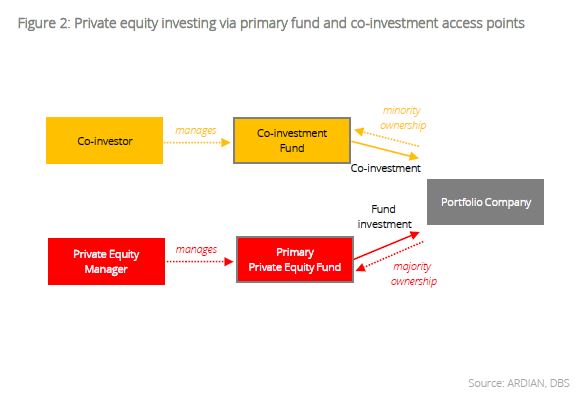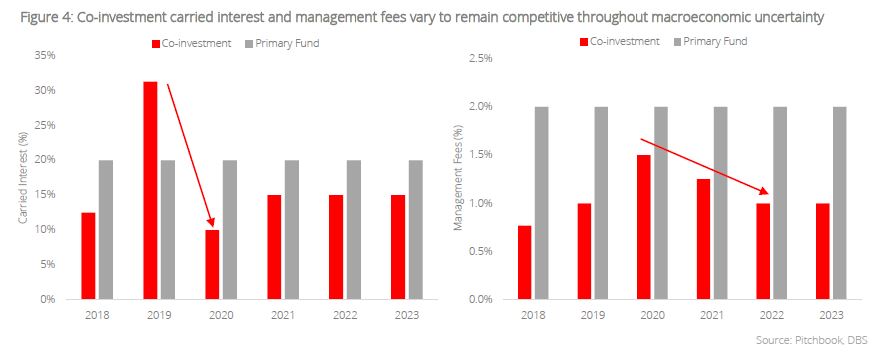- Lower valuations and potential for IRR uplift present a compelling entry point for private equity investors
- Co-investments offer investors control over their private equity portfolio construction, and the flexibility to adjust their deployment strategy as needed.
- Co-investments have demonstrated IRR outperformance during periods of uncertainty, and significant downside attenuation in comparison to primary fund investments.
- Lower fees and carried interest play a key role in generating higher returns for investors.
- Co-investing involves navigating key risks such as adverse selection, and inadequate due diligence due to compressed timelines. Careful GP selection and thorough due diligence are essential to mitigate these risks.
Related insights
- Global Credit 1Q25 – Making Bonds Great Again23 Dec 2024
- Alternatives 1Q25: Gold – Resilience with Alternatives20 Dec 2024
- CIO Insights 1Q25: Game Changers20 Dec 2024

Cheaper at the horizon. Interest rate hikes in the 2022 Fed tightening cycle, and subsequent bouts of public market corrections, precipitated a dip in private equity valuation multiples to 10.8x in 2023, down from the post-GFC (Global Financial Crisis) peak of 11.9x in 2022 – the first downward adjustment in more than a decade. Lower valuations such as these present attractive opportunities for buyers, offering not only cheaper entry points, but also the potential for internal rate of return (IRR) recovery when market conditions improve, especially as the Fed has embarked on a rate cutting cycle.

Co-investments to the fore. The prospect of amenable valuations and IRR uplift in private equity compels the careful selection of private equity access points to reap the most reward in a timely manner. While primary funds provide a foundational and diversified entry to private equity and are naturally the first access point that comes to mind, investors do not gain immediate exposure to underlying assets at prevailing market conditions due to early-stage expenses, and take longer to reach positive returns on committed capital.
Co-investments are spin-offs from the primary fund investing model and offer investors the opportunity to invest alongside General Partners (GPs) outside of the aforementioned primary fund commitment structure. Typically, GPs offering co-investments opportunities have already examined the underlying investments, negotiated the terms of the transactions, and are in the process of closing the investment, but require a larger check than they are momentarily able to write. Co-investors fill the funding gap, and in the process, ride on the GPs’ expertise in deal sourcing, due diligence, and diversification, at an attenuated fee compared to primary fund investors. This arrangement, however, only gets co-investors a minority stake in underlying target portfolio companies. Nevertheless, the arrangement confers co-investors the ability to accelerate their capital deployment into the asset class, and at the prevailing market conditions. Such control over private equity portfolio is paramount. When market environments are favourable, co-investments can be used to build private equity exposure quickly. When valuations become stretched, however, co-investors have the flexibility to taper deployment.

Outperformance more than meets the eye. A comparison of median net IRR of primary funds and co-investments highlight the outperformance of co-investments, which interestingly persisted across bouts of macroeconomic uncertainty since the GFC. The outperformance in net IRR over primary funds during key macroeconomic disruptions from 2017 to 2023, in particular, were in spite of rising private equity valuations, suggesting that the differentiating edge of co-investments likely goes beyond mere enhancements in deal selectivity.

The “fee” advantage. In contrast to primary funds which display a flat management fee and carried interest structure, co-investments show a dynamic management fee and carried interest profile which appears to adjust in response to macroeconomic conditions. At the dawn of the Covid-19 pandemic, carried interest for primary funds were fixed at 20% whereas that for co-investments were down-adjusted three-fold and reached 10%. Similarly, management fees for co-investments tapered down to 1% ahead of the 2022 Fed tightening cycle, whereas that of primary funds remain fixed at 2% (Figure 4). The stark differences in fees and carried interest between primary funds and co-investments during macroeconomic disruptions likely contributed significantly to the IRR disparities observed (Figure 3).

Lower fees pay off. To illustrate the impact of lower fees and carried interest on relative performance, we ran a hypothetical capital distribution model (Figure 5) fitted with median fee values (from Figure 4) under the assumption of 2.0x gross returns for both co-investment and primary funds over a seven-year horizon. The reduction in GP costs led to a 16% increase in net performance for the Limited Partner (LP) in the co-investment program.

All that glitters is gold. Having elucidated the role of lower fees on the outperformance of co-investments over primary funds, we proceeded to examine the downsides of co-investments by generating a probability distribution model of total value paid-in (TVPI) multiples based on 5,000 simulations of sample baskets containing co-investments and primary funds. The model reveals the probabilities of 5.3% and 10.9% for TVPI to dip below 1.00x in co-investments, and primary funds investing, respectively. This suggests that co-investments offer some downside attenuation compared to primary fund investments.

Making a foray into co-investments. Co-investing offers unique opportunities but also presents specific risks that investors must navigate carefully. Uncertainty in the deal pipeline often means that co-investors cannot predict the quality of upcoming deals. This necessitates well-resourced and experienced teams to conduct thorough evaluations as and when opportunities arise. Additionally, compressed response times for co-investments (often closing in a matter of days to weeks) increase the risk of inadequate due diligence. Investors need to be mindful to prioritise rigour above agility to uphold due diligence standards despite time constraints. Next, adverse selection – the risk of GPs offering less attractive deals to co-investors and reserving stronger opportunities for their flagship funds – can result in co-investors allocating disproportionately into deals with high chance of underperformance. This risk may be mitigated by working with reputable GPs who are motivated to offer quality deals to co-investors to foster meaningful long-term relationships. Finally, GPs vary widely in transparency and reporting practices. Working with GPs who are committed to providing comprehensive due diligence materials and consistent performance reporting is paramount.
Topic
The information published by DBS Bank Ltd. (company registration no.: 196800306E) (“DBS”) is for information only. It is based on information or opinions obtained from sources believed to be reliable (but which have not been independently verified by DBS, its related companies and affiliates (“DBS Group”)) and to the maximum extent permitted by law, DBS Group does not make any representation or warranty (express or implied) as to its accuracy, completeness, timeliness or correctness for any particular purpose. Opinions and estimates are subject to change without notice. The publication and distribution of the information does not constitute nor does it imply any form of endorsement by DBS Group of any person, entity, services or products described or appearing in the information. Any past performance, projection, forecast or simulation of results is not necessarily indicative of the future or likely performance of any investment or securities. Foreign exchange transactions involve risks. You should note that fluctuations in foreign exchange rates may result in losses. You may wish to seek your own independent financial, tax, or legal advice or make such independent investigations as you consider necessary or appropriate.
The information published is not and does not constitute or form part of any offer, recommendation, invitation or solicitation to subscribe to or to enter into any transaction; nor is it calculated to invite, nor does it permit the making of offers to the public to subscribe to or enter into any transaction in any jurisdiction or country in which such offer, recommendation, invitation or solicitation is not authorised or to any person to whom it is unlawful to make such offer, recommendation, invitation or solicitation or where such offer, recommendation, invitation or solicitation would be contrary to law or regulation or which would subject DBS Group to any registration requirement within such jurisdiction or country, and should not be viewed as such. Without prejudice to the generality of the foregoing, the information, services or products described or appearing in the information are not specifically intended for or specifically targeted at the public in any specific jurisdiction.
The information is the property of DBS and is protected by applicable intellectual property laws. No reproduction, transmission, sale, distribution, publication, broadcast, circulation, modification, dissemination, or commercial exploitation such information in any manner (including electronic, print or other media now known or hereafter developed) is permitted.
DBS Group and its respective directors, officers and/or employees may have positions or other interests in, and may effect transactions in securities mentioned and may also perform or seek to perform broking, investment banking and other banking or financial services to any persons or entities mentioned.
To the maximum extent permitted by law, DBS Group accepts no liability for any losses or damages (including direct, special, indirect, consequential, incidental or loss of profits) of any kind arising from or in connection with any reliance and/or use of the information (including any error, omission or misstatement, negligent or otherwise) or further communication, even if DBS Group has been advised of the possibility thereof.
The information is not intended for distribution to, or use by, any person or entity in any jurisdiction or country where such distribution or use would be contrary to law or regulation. The information is distributed (a) in Singapore, by DBS Bank Ltd.; (b) in China, by DBS Bank (China) Ltd; (c) in Hong Kong, by DBS Bank (Hong Kong) Limited; (d) in Taiwan, by DBS Bank (Taiwan) Ltd; (e) in Indonesia, by PT DBS Indonesia; and (f) in India, by DBS Bank Ltd, Mumbai Branch.
Related insights
- Global Credit 1Q25 – Making Bonds Great Again23 Dec 2024
- Alternatives 1Q25: Gold – Resilience with Alternatives20 Dec 2024
- CIO Insights 1Q25: Game Changers20 Dec 2024
Related insights
- Global Credit 1Q25 – Making Bonds Great Again23 Dec 2024
- Alternatives 1Q25: Gold – Resilience with Alternatives20 Dec 2024
- CIO Insights 1Q25: Game Changers20 Dec 2024

